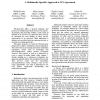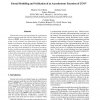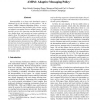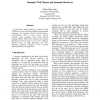ECOWS
2006
Springer
14 years 3 months ago
2006
Springer
WS-Agreement offers a general language and protocol to establish agreements between two parties. In principle, this generality enables a wide variety of domains to be covered. Yet...
ECOWS
2006
Springer
14 years 3 months ago
2006
Springer
A broader use of e-services for cross enterprise collaboration requires the services to be analysed and designed with a clear business focus. From a business perspective, the e-se...
ECOWS
2006
Springer
14 years 3 months ago
2006
Springer
Current web services are largely based on a synchronous request-response model that uses the Simple Object Access Protocol SOAP. Next-generation telecommunication networks, on the...
ECOWS
2006
Springer
14 years 3 months ago
2006
Springer
Interoperability in a large-scale distributed system is challenged by by the diversity of node policies. We introduce AMPol (Adaptive Messaging Policy), a serviceoriented architec...
ECOWS
2006
Springer
14 years 3 months ago
2006
Springer
Emerging semantic web service description formalisms, such as OWL-S, allow for a definition of the semantic of services. Describing input and output types is not sufficient to dec...
ECOWS
2006
Springer
14 years 3 months ago
2006
Springer
This paper is about Web services used in distributed, inter-organizational business cooperation (choreography). In this application scenario, we have a multipart functional conven...
ECOWS
2006
Springer
14 years 3 months ago
2006
Springer
Semantic Web Services are generally considered as the evolution of conventional Web Services. Semantic information included in the service descriptions enables the development of ...
ECOWS
2006
Springer
14 years 3 months ago
2006
Springer
Traditional process support systems offer the promise of software assembled from service elements. The typical approach is a static composition of atomic processes to more powerfu...
ECOWS
2006
Springer
14 years 3 months ago
2006
Springer
In this paper, author proposes a solution to make URI Resolver class available in different programming languages. The Semantic Resolver derived from a corresponding .NET or Java ...
ECOWS
2006
Springer
14 years 3 months ago
2006
Springer
Measurement of semantic similarity between Web services is an important factor for Web service discovery, composition, and even execution. Semantic Web services (SWS) are usually ...




